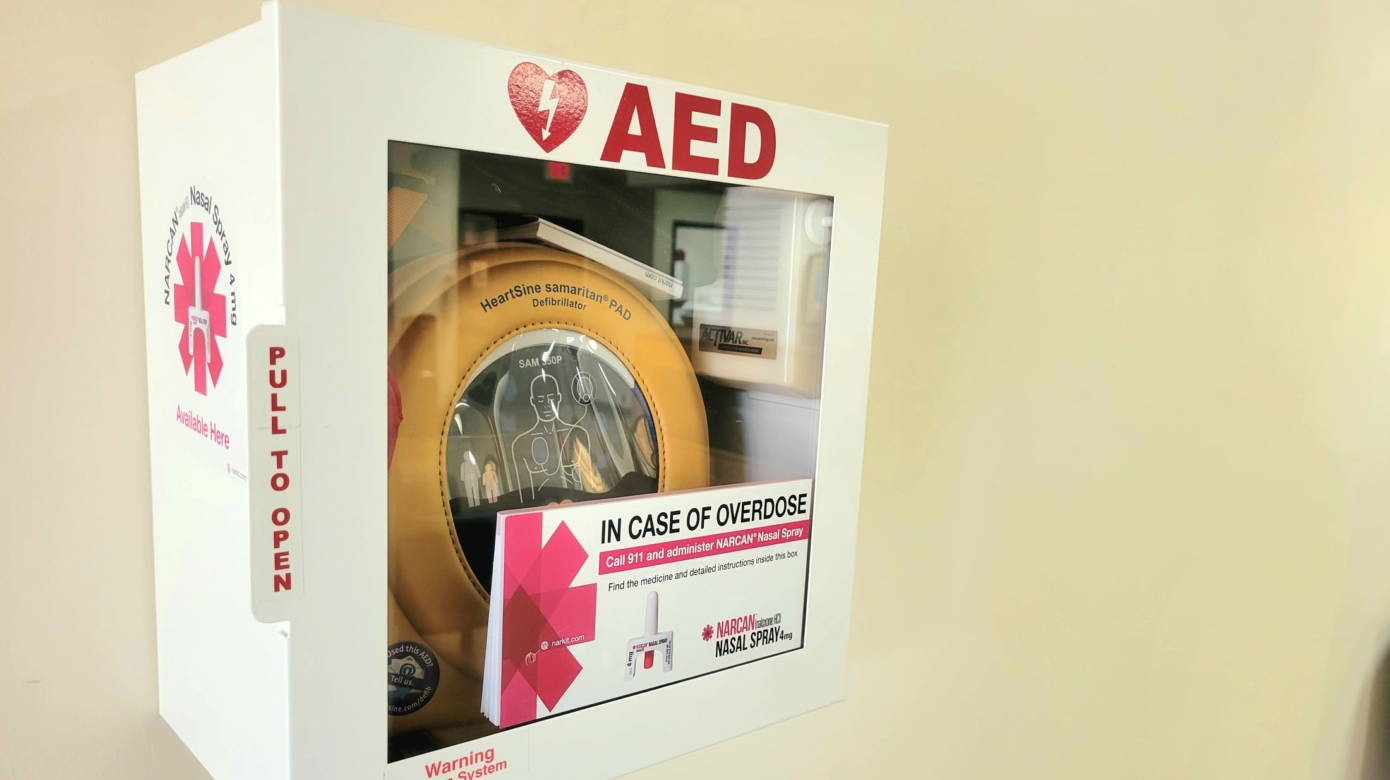Every day in America, 256 people die from a drug overdose. According to the Centers for Disease Control and Prevention, overdose deaths involving opioids have increased by more than eight times since 1999. In 2020, there were 91,799 overdose deaths, 75% of them involving opioids.
Citizen Potawatomi Nation is making a change throughout its organization to help reduce that number. This year, NARCAN was added to all AED cabinets at Tribal enterprises and offices.
NARCAN, or naloxone, is an opiate antidote that attaches to opioid receptors, then temporarily blocks and reverses the effects of opioids. The AED cabinets, which already housed an automated external defibrillator for cardiac arrest emergencies, now always include one to two doses of NARCAN.
The cabinets include written and voice instructions for how to administer NARCAN.
“So, you press this, and it goes through the four steps and repeats them over and over,” said Chad Stieben, CPR and First Aid instructor for CPN, demonstrating a button on the NARCAN kit. “It’s helping you remember in a stressful situation what to do.”
Stieben started adding NARCAN to the Tribe’s 98 AED cabinets in March. Leading up to the change, he also conducted a week of classes explaining the use of the NARCAN. In the future, he plans to add that information to the CPR classes as well.
“Everyone, I believe, should be trained on using NARCAN, and adding it to the AED cabinets is very important to save lives,” said CPN Nurse Coordinator April Crockett. “The opioid overdose deaths have skyrocketed during the pandemic, killing more than 69,000 people. … It is important that we are prepared in a crisis situation and cannot just wait for something to happen.”
Employee training
To prepare for the change, CPN offered four Overdose Lifeline, Inc., courses each day for the week of March 20-24. A total of 175 attended the classes led by Stieben.
Kari Thornton, payroll and benefits manager for CPN, was one of those students, and she said the entire human resources department planned to attend as well.
“I personally have a family member that was affected by Fentanyl,” she said. “I lost a 22-year-old nephew this past year. So, I really understand the importance of the training. It is so scary what our kids and young adults are facing right now.”
Thornton carries NARCAN with her just in case anyone needs it. Though she was already familiar with how to use it, she found the training helpful — especially a segment when a video was shown demonstrating how to administer NARCAN.
Crockett said the training has already paid off, and that the Tribal police used NARCAN in the field to prevent someone becoming another statistic in the opioid crisis.
“I was extremely glad that this is something we can offer all around the Tribe to help the growing crisis,” Crockett said.
Overdose response
Symptoms of an opioid overdose can include pale face, clammy skim, limpness, fingernails or lips turning blue or purple, vomiting, slowed breathing or heartbeat, and unresponsiveness.
If an opioid overdose is suspected, Stieben said to start by immediately calling 911 and sending someone to meet paramedics to show them where the emergency is happening.
The person experiencing a potential overdose should be rested on their back, with their head tilted back and support provided for their neck. Insert the tip of the nasal spray all the way into the nostril, so that none of the dosage is missed, and then press the plunger to administer the NARCAN. Stieben also explained it is important to remember which nostril is used. If a second dose is necessary, it needs to be administered in the other nostril.
Once the dose is administered, the person should be placed into the recovery position on their side and then monitored. If they do not improve within 2 to 3 minutes, a second dose of NARCAN can be administered.
“A good thing to remember is that there are no adverse effects with NARCAN. So even if someone is overdosing on something that’s not an opioid and you try to give them NARCAN, it’s not going to help them, but it’s also not going to hurt them,” Stieben said.
If at any point the person stops breathing, Stieben said to begin CPR as soon as the NARCAN is administered.
After administering NARCAN, Stieben said to be aware that people can sometimes be combative when they wake up from a traumatic experience like an overdose, so it is important to give them space.
Stieben explained again the importance of calling 911 any time there is a suspected overdose.
“Naloxone lasts 30 to 60 minutes. The half life of an opioid may be much longer,” he said. “So that means that you always, always want to have someone who is in overdose or has been in overdose to go to the hospital. If the opioid is stronger than the NARCAN and it lasts longer than 30 to 60 minutes, they will be in danger of overdosing again.”
Prepared to help
Stieben said it is a good idea for anyone to have NARCAN available, including those with opioid prescriptions. Accidental overdoses are not necessarily common, but sometimes a person, especially older individuals with memory issues, might forget and take pills more than once, which could lead to an overdose.
In Oklahoma, it is possible to get NARCAN through a licensed pharmacist without a prescription for an opioid. It should not be stored in extreme temperatures or exposed to direct sunlight, and it should always be kept within the expiration date.
Similar to CPR, Stieben said anyone acting in good faith who administers NARCAN is protected under the Good Samaritan Law.
For more information about NARCAN, visit cdc.gov/stopoverdose/naloxone.

